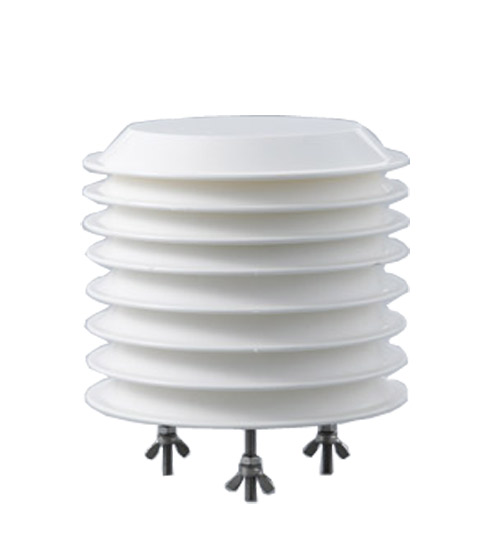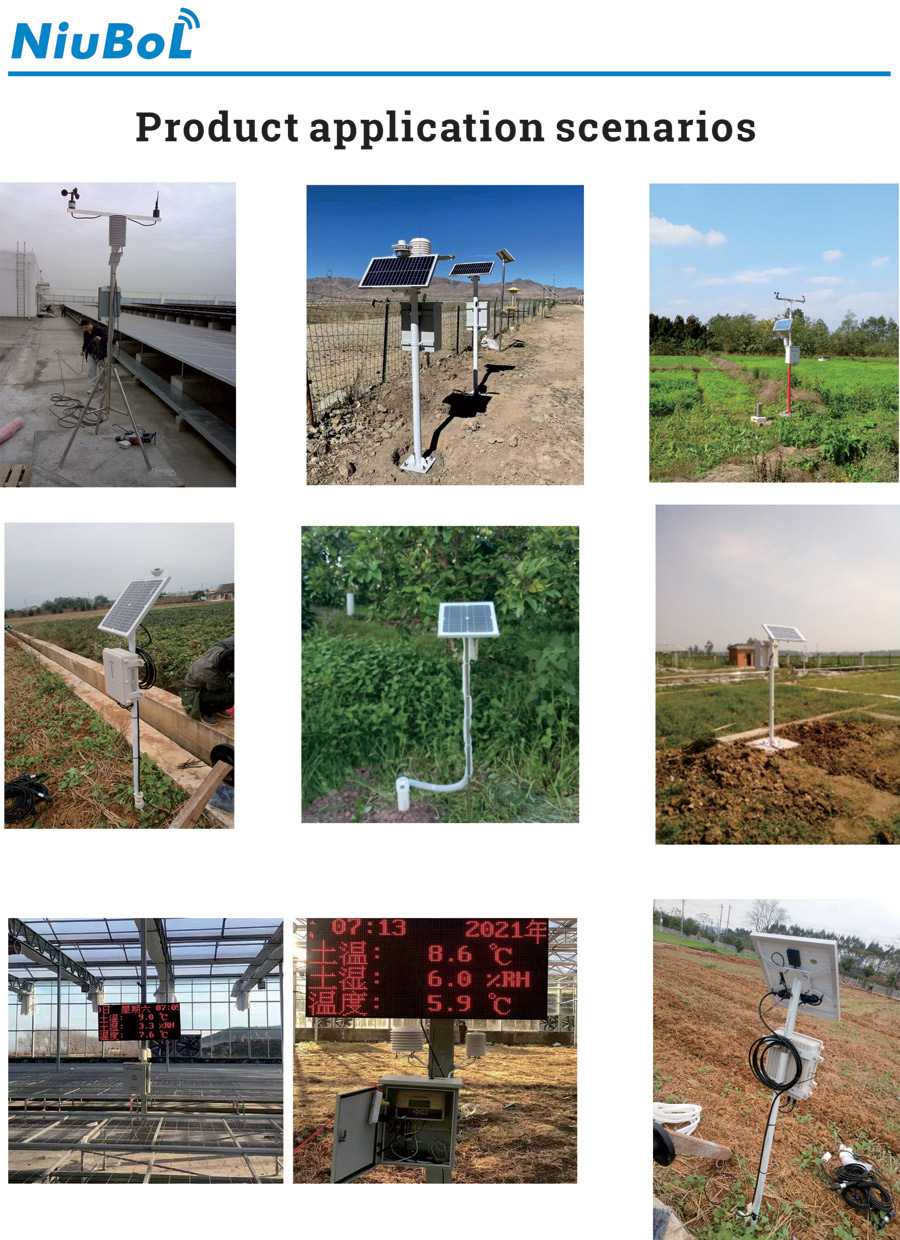

— Products —
 Consumer hotline +8618073152920
Consumer hotline +8618073152920 WhatsApp:+8615367865107
Address:Room 102, District D, Houhu Industrial Park, Yuelu District, Changsha City, Hunan Province, China
All products
agricultural weather station is a device or system used to monitor and record agricultural weather parameters. It usually includes various sensors for measuring and monitoring meteorological parameters such as air temperature, relative humidity, rainfall, wind speed, wind direction, solar radiation, and soil parameters such as soil temperature and soil moisture. agricultural meteorological stations play an important role in agricultural production and scientific research. Thr···
Tel/WhatsApp:+8615367865107
Email:Arvin@niubol.com +Nearly 100 partner company in more than 68 countries. We are committed to providing high-quality, practical products to meet your needs and help you solve problems.Product Details
An agricultural weather station is a device or system used to monitor and record agricultural weather parameters. It usually includes various sensors for measuring and monitoring meteorological parameters such as air temperature, relative humidity, rainfall, wind speed, wind direction, solar radiation, and soil parameters such as soil temperature and soil moisture.
The main role of agrometeorological stations is to provide a basis for decision-making in agricultural production and management. Through real-time monitoring of meteorological and soil parameters, it can help farmers understand the growth status and environmental conditions of farmland and take timely and appropriate management measures, such as irrigation, fertilization and spraying. At the same time, the agrometeorological station can also help researchers conduct research on agrometeorology, explore the impact and mechanism of climate change on agriculture, and provide scientific support for sustainable agricultural development.
In addition, agricultural weather stations can be combined with agricultural Internet of Things systems to transmit monitoring data to cloud platforms or data centers for storage and analysis, and realize remote monitoring and management. This technology helps to improve the management level of agricultural production and the degree of intelligence, providing technical guarantee for the precision and intelligence of agricultural production.
In conclusion, agricultural meteorological stations play an important role in agricultural production and scientific research. Through real-time monitoring of meteorological and soil parameters, it provides a decision-making basis for agricultural production and management and promotes the sustainable development of agriculture.
| Measured | Measuring range | Resolution | Precision |
| Humidity | 0~100%RH | 0.1%RH | ±0.5℃ |
| Temperature | -40~80℃ | 0.1℃ | ±5%RH |
| Atmospheric pressure | 10~1200hPa | 0.1hPa | ±1.5hPa |
| Soil temperature | -40~80℃ | 0.1℃ | ±0.5℃ |
| Soil Humidity (moisture) | 0-100%RH | 0.1%RH | ±5%RH |
| Conductivity | 0-10000us/cm | 1us/cm | ±5% |
| Wind speed | 0~70m/s | 0.1m/s | ±(0.3+0.03V)m/s |
| wind direction | 0~360° | - | ±3° |
| Illuminance | 0-200000Lux | - | ±7% |
| Rainfall | 0-4mm/min | 0.2mm | ±4% |
| Solar radiation | 0~2000W/m2 | - | ≤5% |
| CO2 | 0~2000ppm | 1ppm | ±7% |
| Supply mode | 220V | DC12-24V | solar power optional |
 |  |  |  |  |
| Anemometer Wind Speed sensor | Wind direction sensor | Tipping bucket rain gauge sensor | Tipping bucket rain gauge sensor | Piezoelectric Rain Gauge |
 |  |  |  |  |
| Atmospheric Temperature Humidity air pressure Sensor | ultrasonic wind speed and direction sensor | 5 in1 Ultrasonic Weather Station Sensor | 6 in1 Ultrasonic Weather Station Sensor | 7 in1 Ultrasonic Weather Station Sensor |
 |  |  |  |  |
| Carbon dioxide sensor | Solar Radiation Sensor | Photosynthetically Active Radiation Sensor; | illumination sensor | Soil Moisture Temperature sensor |
An agricultural weather station is a specialized weather monitoring system designed specifically for agricultural applications. It provides real-time data on various weather parameters that are crucial for effective agricultural management and decision-making. Here are some key features and components commonly found in agricultural weather stations:
1. Weather Sensors: Agricultural weather stations typically include a range of sensors to measure weather variables such as temperature, relative humidity, rainfall, wind speed and direction, solar radiation, and atmospheric pressure. These sensors are usually placed at strategic locations within the farm or field to capture accurate and representative weather data.
2. Data Logger: A data logger is an essential component of an agricultural weather station. It collects, stores, and timestamps the data from the weather sensors at regular intervals. The data logger ensures continuous monitoring of weather conditions and allows for data analysis over time.
3. Communication System: Agricultural weather stations often have a communication system, such as GSM, Wi-Fi, or Ethernet, to transmit data to a central database or a remote server. This enables farmers or agricultural professionals to access real-time weather information from any location using computers or mobile devices.
4. Software and Data Visualization: The collected weather data is typically processed and analyzed using specialized software. This software provides tools for visualizing data trends, generating reports, and making informed decisions based on the weather information. Some agricultural weather stations may also integrate with existing agricultural management software or platforms.
5. Additional Sensors and Features: Depending on the specific agricultural needs, additional sensors can be added to an agricultural weather station. For example, soil moisture sensors, leaf wetness sensors, or evapotranspiration sensors can provide valuable information for irrigation scheduling and crop health monitoring.
The data collected from an agricultural weather station helps farmers optimize irrigation, manage pest and disease risks, schedule planting and harvesting operations, and make informed decisions related to crop management. By understanding the weather conditions in real-time and analyzing historical data, farmers can improve productivity, reduce resource consumption, and enhance overall farm management.

Providing accurate meteorological data: Agricultural meteorological stations can monitor real-time changes in wind, temperature, humidity, air pressure, grass temperature and other meteorological elements, as well as data on soil moisture content, to provide accurate meteorological information for farmers, help them understand the current climatic conditions, and provide a scientific basis for agricultural production.
Monitoring disaster weather: Agricultural weather stations utilize the global weather monitoring system to keep abreast of weather changes and predict natural disasters such as droughts, floods, blizzards and other weather conditions, helping farmers to prevent and mitigate agricultural disaster losses in a timely manner.
Promoting rational planting: Agricultural weather stations can provide scientific research services for agricultural production, providing different information according to the monitoring of different meteorological factors, so that farmers can make timely adjustments to the cultivation time of crops, scientific fertilizer application, irrigation water quantity and other agricultural activities.
Provide information on agricultural environmental protection: Agricultural meteorological stations use new technology and equipment to submit air, water quality and soil measurement data to provide accurate information on agricultural environmental protection and help farmers apply fertilizers in a scientific and reasonable manner to reduce agricultural pollution.
Monitoring environmental changes: Agro-meteorological stations are able to monitor environmental changes, such as soil temperature and PH value, which can assist decision makers in optimizing management strategies for irrigation, fertilization, sowing and harvesting in the process of large-scale agricultural production.
Provide scientific decision-making for governmental organizations: Agrometeorological stations can also provide scientific research services for agricultural production, and at the same time provide scientific decision-making for governmental organizations to ensure safe and healthy agricultural production.
To summarize, the role of agricultural weather stations is to provide accurate meteorological data, monitor disaster weather, promote rational planting, provide information on agricultural environmental protection, monitor environmental changes, and provide scientific decision-making for government agencies. These roles help to improve the management level and intelligence of agricultural production and provide technical guarantee for the precision and intelligence of agricultural production.
1. Selection of an appropriate location: Choose a location that accurately reflects the typical meteorological conditions of the area. Avoid installing the weather station in areas subject to human interference, such as near buildings, trees or other objects.
2. Sensor Arrangement: According to the needs, arrange the weather sensors reasonably so that they can measure different weather parameters accurately. Avoid mutual blockage between sensors and the proximity of objects that may cause errors.
3. Safety and solidity: Ensure that the weather station equipment is firmly installed, stable and not easily disturbed by external forces. Use appropriate brackets or fixtures, and ensure that all components are firmly connected.
4. Power supply: Ensure that a stable and reliable power supply is provided. Choose the appropriate power supply method according to the specific situation, such as alternating current, solar panels or batteries.
5. Lightning protection: Consider weather conditions and regional lightning activity and take appropriate lightning protection measures, such as installing lightning rods or grounding systems, to protect the equipment from lightning damage.
6. Maintenance and calibration: Regularly inspect and maintain the agrometeorological station equipment to ensure proper operation. Calibrate sensors to ensure accurate measurements and replace any damaged or failed parts in a timely manner.
7. Data logging and management: Configure proper data logging settings to ensure accurate recording and storage of data. Set up a proper data management system to easily access and analyze weather data.
Please note that when installing an agricultural weather station, local codes and regulations should be followed, especially those involving land use and equipment installation. It is recommended to consult a professional for more detailed guidance if needed.

Sensors & Weather Stations Catalog
Agriculture Sensors and Weather Stations Catalog-NiuBoL.pdf
Weather Stations Catalog-NiuBoL.pdf
Related recommendations
 Multi-Depth Soil Sensor RS485
Multi-Depth Soil Sensor RS485 TDR Soil Moisture Sensor
TDR Soil Moisture Sensor Pyranometer Solar Radiation Sensors
Pyranometer Solar Radiation Sensors Soil ph sensor
Soil ph sensor Tipping Bucket Rain Gauge
Tipping Bucket Rain Gauge Air Temperature and Humidity Sensor
Air Temperature and Humidity Sensor
Screenshot, WhatsApp to identify the QR code
WhatsApp number:+8615367865107
(Click on WhatsApp to copy and add friends)
